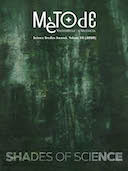Vestiges of our first steps: An evolutionary view of the supracondylar syndrome
DOI:
https://doi.org/10.7203/metode.10.15032Keywords:
supracondylar syndrome, entepicondylar foramen, first tetrapods, atavisms, vestigial organs Abstract
Abstract
Understanding the evolution and function of structures in the past is key to understanding current biodiversity. This paper shows how an evolutionary perspective can help us to understand supracondylar syndrome. This pathology is caused by compression of the median nerve and/or the brachial artery in the arm and affects a significant percentage of the human population. We propose that this neuropathy is an atavism (the reappearance of an ancestral characteristic that had been lost along our evolutionary lineage) of the entepicondylar foramen: a channel present at the lower end of the humerus through which the brachial artery and the median nerve pass in some mammals. The origin of the foramen has been identified in the first tetrapods, and we propose that its original function could be linked to the evolutionary innovation of the cervical brachial plexus as well as the subsequent evolution of the entepicondylar foramen in amniotes – a group of terrestrial vertebrates that encompasses current reptiles and amphibians – and that it may be vestigial.
 Downloads
Downloads
 References
References
Clack, J. A. (2012). Gaining ground: the origin and evolution of tetrapods. Bloomington, IN: Indiana University Press.
Darwin, C. (1871). The descent of man and selection in relation to sex (Vol. 1). London: John Murray.
Fürbringer, M. (1888). Untersuchungen zur Morphologie und Systematik der Vögel: zugleich ein Beitrag zur Anatomie der Stütz- und Bewegungsorgane. Amsterdam: T. van Holkema.
Hall, B. K. (1984). Development mechanisms underlying the formation of atavisms. Biological Reviews of Cambridge Philosophical Society, 59(1), 89–122. doi: 10.1111/j.1469-185X.1984.tb00402.x
Hirasawa, T., & Kuratani, S. (2018). Evolution of the muscular system in tetrapod limbs. Zoological Letters, 4(1), 27. doi: 10.1186/s40851-018-0110-2
Home, E. (1814). Lectures on comparative anatomy (Vol. 1).London: G. and W. Nicol.
Huntington, G. S. (1918). Modern problems of evolution, variation and inheritance in the anatomical part of the medical curriculum. The Anatomical Record, 14(6), 359–445. doi: 10.1002/ar.1090140605
Koo, J. T., & Szabo, R. M. (2004). Compression neuropathies of the median nerve. Journal of the American Society for Surgery of the Hand, 4(3), 156–175. doi: 10.1016/j.jassh.2004.06.007
Landry, S. O., Jr. (1958). The function of the entepicondylar foramen in mammals. The American Midland Naturalist, 60(1), 100–112. doi: 10.2307/2422468
Meckel, J. F. (1825). System der Vergleichenden Anatomie. Band 2, Abt. II. Leipzig: Halle.
Opanova, M. I., & Atkinson, R. (2014). Supracondylar process syndrome: case report and literature review. The Journal of Hand Surgery, 39(6), 1130–1135. doi: 10.1016/j.jhsa. 2014.03.035
Otto, A. (1839). De rariorbus quisbusdam sceleti humani cum animalum sceleto analogis. In De canalis supracondyloidei ossis humeri in homine vestigo. Wrocław: s. e.
Ruge, G. (1884). Beitrage zur Gefasslehre des Menschen. Morphologisches Jahrbuch, 9, 329–388.
Shubin, N. H., & Alberch, P. A. (1986). A morphogenetic approach to the origin and basic organization of the tetrapod limb. Evolutionary Biology, 20, 319–387. doi: 10.1007/978-1-4615-6983-1_6
Smithson, T. R., & Clack, J. A. (2018). A new tetrapod from Romer’s Gap reveals an early adaptation for walking. Earth and Environmental Science Transactions of the Royal Society of Edinburgh, 108(1), 89–97. doi: 10.1017/S1755691018000075
Stromer, E. (1902). Ueber die Bedeutung des Foramen entepicondyloideum und des Trochanter tertius der Saugethiere. Morphologisches Jahrbuch, 29, 553–562.
Struthers, J. (1848). On a peculiarity of the humerus and humeral artery. Monthly Journal of Medical Science, 3(28), 264–267.
Tiedemann, F. (1818). Ueber einem am Oberarmbein bei mehreren gefchwänten Affen vorkommenden Kanal und eine damit in Verbindung ftehende befondere Anordnung der Arterien und Nerven des Arms. Deutches Archiv für die Physiologie, 4, 544–548.
Downloads
Published
How to Cite
-
Abstract1143
-
PDF602
Issue
Section
License
![]()
All the documents in the OJS platform are open access and property of their respective authors.
Authors publishing in the journal agree to the following terms:
- Authors keep the rights and guarantee Metode Science Studies Journal the right to be the first publication of the document, licensed under a Creative Commons Attribution-NonCommercial-NoDerivatives 4.0 International License that allows others to share the work with an acknowledgement of authorship and publication in the journal.
- Authors are allowed and encouraged to spread their work through electronic means using personal or institutional websites (institutional open archives, personal websites or professional and academic networks profiles) once the text has been published.





